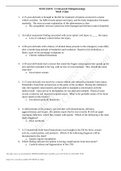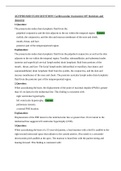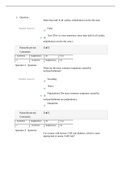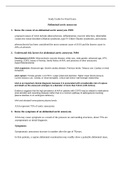Shukrishinaz
On this page, you find all documents, package deals, and flashcards offered by seller Shukrishinaz.
- 7
- 0
- 0
Community
- Followers
- Following
7 items

NURS 6501N Week 3 Quiz 1 with Answers (25/25 Points)
NURS 6501N Week 3 Quiz - Advanced Pathophysiology 1. A 72-year-old male demonstrates the left-sided weakness of upper and lower extremities. The symptoms lasted 24 hours and resolve with no evidence of infarction. The patient most likely experienced a(n): 2. When a patient has a peculiar sensation that immediately precedes a seizure, what term should the nurse use to describe this sensation? 3. The nursing student would correctly identify the most common symptom of brain ...
- Exam (elaborations)
- • 4 pages •
NURS 6501N Week 3 Quiz - Advanced Pathophysiology 1. A 72-year-old male demonstrates the left-sided weakness of upper and lower extremities. The symptoms lasted 24 hours and resolve with no evidence of infarction. The patient most likely experienced a(n): 2. When a patient has a peculiar sensation that immediately precedes a seizure, what term should the nurse use to describe this sensation? 3. The nursing student would correctly identify the most common symptom of brain ...

NURS 6501N Midterm Exam 1 - Question and Answers (July 2020 - 100 out of 100)
A professor has taught the students about the pathogenesis of abdominal pain. Which statement by a student indicates the professor needs to review the material? 2. Which cardiac chambers have the thinnest wall and why? 3. A healthcare provider notes that tapping the patient's facial nerve leads to lip twitching. What electrolyte value is correlated with this finding? 4. What is the cause of functional dysphagia? 5. Which gastric hormone inhibits acid and pepsinogen secretion, as wel...
- Exam (elaborations)
- • 18 pages •
A professor has taught the students about the pathogenesis of abdominal pain. Which statement by a student indicates the professor needs to review the material? 2. Which cardiac chambers have the thinnest wall and why? 3. A healthcare provider notes that tapping the patient's facial nerve leads to lip twitching. What electrolyte value is correlated with this finding? 4. What is the cause of functional dysphagia? 5. Which gastric hormone inhibits acid and pepsinogen secretion, as wel...

NURS 6501N Week 4 Quiz 3 with Answers (30/30 Points)
1. A 50-year-old male is diagnosed with orthostatic hypotension. Which of the following symptoms would he most likely experience? 2. An 82-year-old female was admitted to the hospital with confusion and severe hypotension. Her body’s compensatory mechanisms are increased heart rate, vasoconstriction, and movement of large volumes of interstitial fluid to the vascular compartment. What kind of shock does the nurse suspect the patient is experiencing? 3. A 50-year-old male visits the cardi...
- Exam (elaborations)
- • 4 pages •
1. A 50-year-old male is diagnosed with orthostatic hypotension. Which of the following symptoms would he most likely experience? 2. An 82-year-old female was admitted to the hospital with confusion and severe hypotension. Her body’s compensatory mechanisms are increased heart rate, vasoconstriction, and movement of large volumes of interstitial fluid to the vascular compartment. What kind of shock does the nurse suspect the patient is experiencing? 3. A 50-year-old male visits the cardi...

AGNP Board Exam - Question and Answers - Cardiovascular Assessment
1. The preauricular nodes drain lymphatic fluid from the: 2. When auscultating the heart, the displacement of the point of maximal impulse (PMI) is greater than 10 cm lateral to the midsternal line. This finding is consistent with: 3. When auscultating the heart of a 55-year-old patient, a loud murmur with a thrill is audible in the right second intercostal space that radiates to the carotid arteries. Also noted is a crescendo-decrescendo pitch audible at the apex. The murmur is heard best...
- Exam (elaborations)
- • 46 pages •
1. The preauricular nodes drain lymphatic fluid from the: 2. When auscultating the heart, the displacement of the point of maximal impulse (PMI) is greater than 10 cm lateral to the midsternal line. This finding is consistent with: 3. When auscultating the heart of a 55-year-old patient, a loud murmur with a thrill is audible in the right second intercostal space that radiates to the carotid arteries. Also noted is a crescendo-decrescendo pitch audible at the apex. The murmur is heard best...

NSG 6001 Final Exam 1
NSG 6001 Final Exam More than half of all cardiac arrhymias involve the atria What are the most common symptoms caused by tachyarryhthmias For women with known cad and diabetes, which is the most appropriate to assess CAD risk Of the following, which is the best answer when asked about the advantage of echocardiogram exercise testing over thallium stress testing You patient has uncomplicated pyelonephritis. In deciding your recommended treatment, you consider the most common pathogenic re...
- Exam (elaborations)
- • 33 pages •
NSG 6001 Final Exam More than half of all cardiac arrhymias involve the atria What are the most common symptoms caused by tachyarryhthmias For women with known cad and diabetes, which is the most appropriate to assess CAD risk Of the following, which is the best answer when asked about the advantage of echocardiogram exercise testing over thallium stress testing You patient has uncomplicated pyelonephritis. In deciding your recommended treatment, you consider the most common pathogenic re...

NSG6001 mid term
A 35 year old female arrives at your clinic. She has had diabetes and peripheral artery disease for the past 5 years. You decide to obtain an ETT. The insurance company argues that this is inappropriate. You justify the ETT because you are planning secondary strategies to prevent future heart disease. Where could one find the supporting data for these guidelines? 2. You are counseling a patient diagnosed with stress-induced ischemia. You base your discussion on your knowledge that stress-indu...
- Exam (elaborations)
- • 9 pages •
A 35 year old female arrives at your clinic. She has had diabetes and peripheral artery disease for the past 5 years. You decide to obtain an ETT. The insurance company argues that this is inappropriate. You justify the ETT because you are planning secondary strategies to prevent future heart disease. Where could one find the supporting data for these guidelines? 2. You are counseling a patient diagnosed with stress-induced ischemia. You base your discussion on your knowledge that stress-indu...

NSG 6001 Final Exam Study Guide
NSG 6001 Final Exam Study Guide Abdominal aortic aneurysm Know the causes of an abdominal aortic aneurysm. P493 Understand risk factors for abdominal aortic aneurysm. P494 Development of AAA AAA expansion AAA rupture AAA is an important clinical diagnosis because it is associated with considerable risk of rupture and death as the aneurysm enlarges to a diameter of more than 5.0cm (1.96 inches). Know the symptoms of an abdominal aortic aneurysm. Symptoms: Symptom and sign of a ruptured AAA classi...
- Exam (elaborations)
- • 10 pages •
NSG 6001 Final Exam Study Guide Abdominal aortic aneurysm Know the causes of an abdominal aortic aneurysm. P493 Understand risk factors for abdominal aortic aneurysm. P494 Development of AAA AAA expansion AAA rupture AAA is an important clinical diagnosis because it is associated with considerable risk of rupture and death as the aneurysm enlarges to a diameter of more than 5.0cm (1.96 inches). Know the symptoms of an abdominal aortic aneurysm. Symptoms: Symptom and sign of a ruptured AAA classi...
